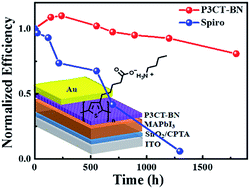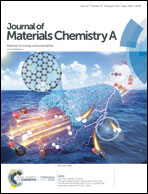A dopant-free polyelectrolyte hole-transport layer for high efficiency and stable planar perovskite solar cells†
Abstract
Spiro-OMeTAD is a commonly used hole transport material (HTM) in regular device structures. However, a complex and uncontrollable oxygen doping process is necessary. To avoid the drawbacks of dopants, a polyelectrolyte (P3CT-BN) is introduced as a dopant-free HTM. The C![[double bond, length as m-dash]](https://www.rsc.org/images/entities/char_e001.gif) O group on P3CT-BN could interact with bare Pb at the perovskite surface, which facilitates hole transfer at the perovskite/HTL interface. The P3CT-BN layer could reduce interfacial recombination and exhibits outstanding film-forming properties. Thus the efficiency of the best device is improved from 18.26% to 19.05% when replacing Spiro-OMeTAD with P3CT-BN. Moreover, devices based on P3CT-BN exhibit outstanding stability, retaining 80% of their original performance after storage in the atmosphere (30–40% relative humidity) for 1800 h without encapsulation. These results indicate that P3CT-BN can be an effective HTM to realize high efficiency and stable PSCs.
O group on P3CT-BN could interact with bare Pb at the perovskite surface, which facilitates hole transfer at the perovskite/HTL interface. The P3CT-BN layer could reduce interfacial recombination and exhibits outstanding film-forming properties. Thus the efficiency of the best device is improved from 18.26% to 19.05% when replacing Spiro-OMeTAD with P3CT-BN. Moreover, devices based on P3CT-BN exhibit outstanding stability, retaining 80% of their original performance after storage in the atmosphere (30–40% relative humidity) for 1800 h without encapsulation. These results indicate that P3CT-BN can be an effective HTM to realize high efficiency and stable PSCs.



 Please wait while we load your content...
Please wait while we load your content...